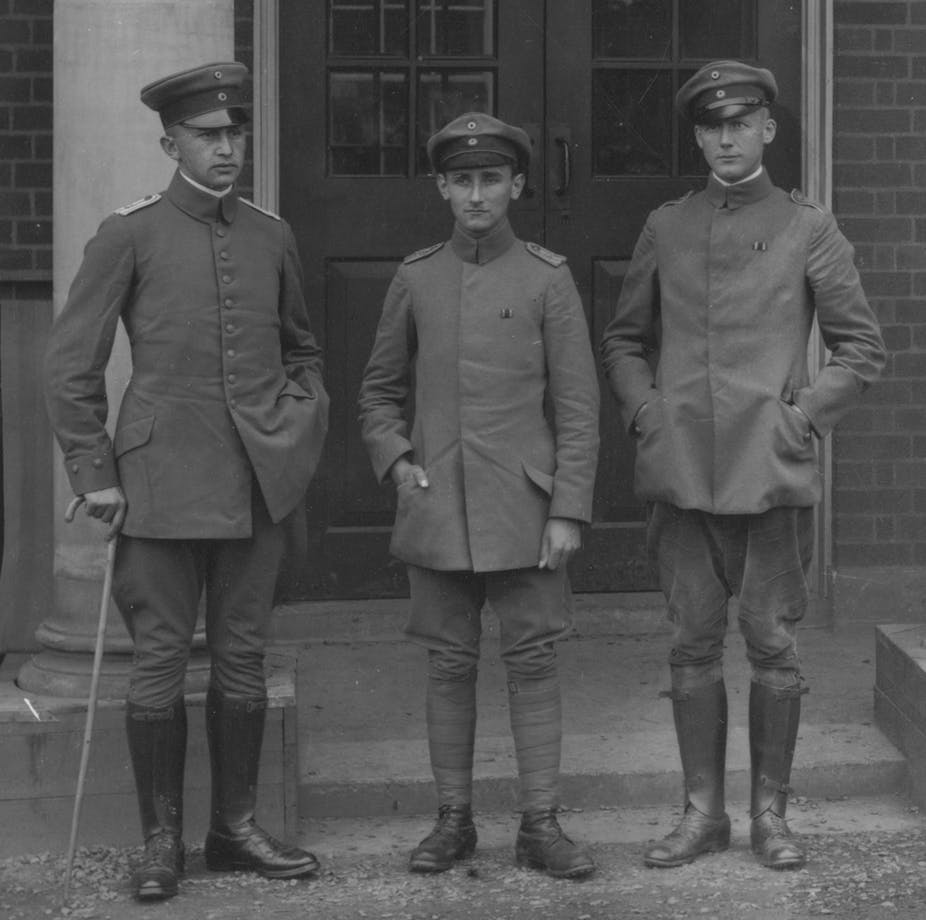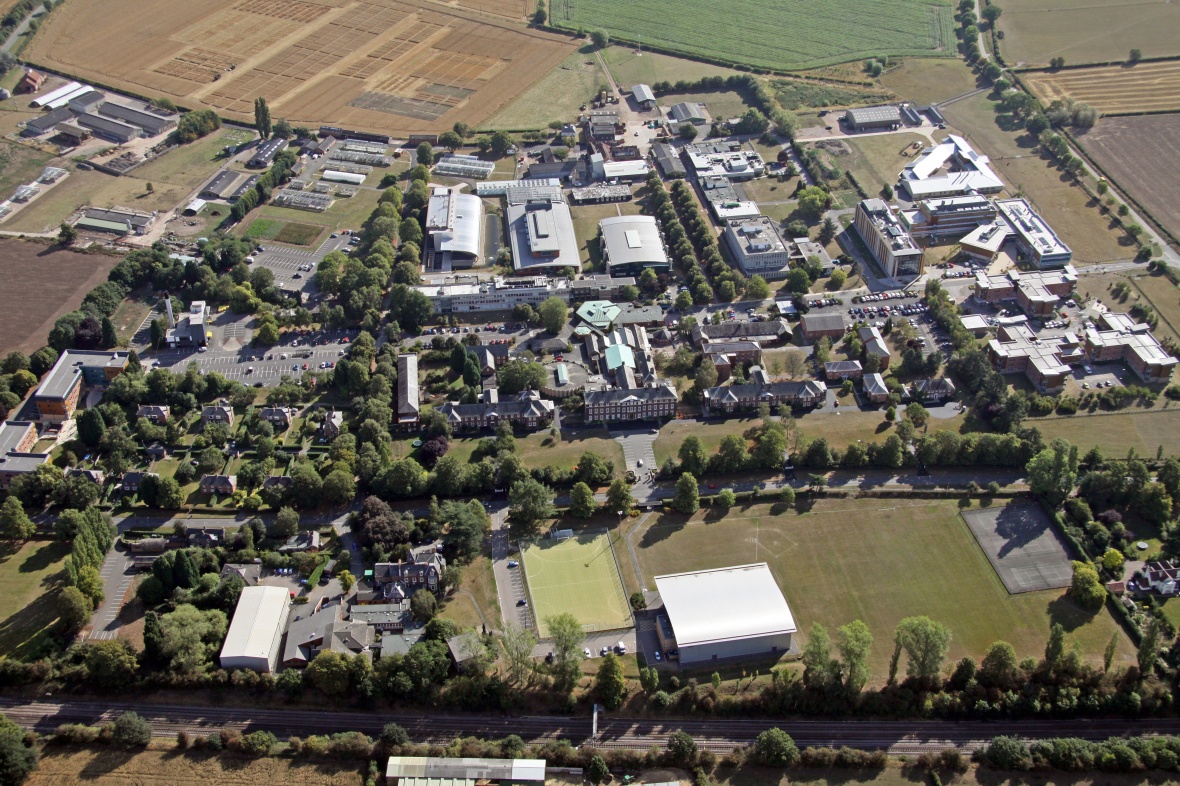Wednesday, 23 October 2019
A unique collection of previously unseen photographs that reveal what life was like for German soldiers in an East Midlands WW1 prisoner of war camp will be on show in a new exhibition opening this week.
The exhibition is part of a research project involving historians from the University of Nottingham and the W.W. Winter Heritage Trust in Derby. Founded in 1882, W.W. Winters is believed to be the longest running photography business in Britain.
This new WW1 research was inspired by local historian Jane Middleton-Smith after she unearthed a collection of glass plate negatives and prints in the Winters company archives. The photographs were taken by Winter’s photographers at the PoW camp in and around 1917.
 ©University of Nottingham Department of Manuscripts and Special Collections
©University of Nottingham Department of Manuscripts and Special Collections
The camp was a dual site, comprising the Midland Agricultural College at Sutton Bonington – now the university’s Biosciences and Veterinary Medicine campus – and the stately home Donington Hall near Castle Donington. Around 200 German officers, orderlies and a few civilians were held at the camp between 1915 and 1919 when it was decommissioned after the end of the war.
Over the past two years, Middleton-Smith and W.W. Winter staff have been working with researchers at the Universities of Nottingham and Derby on the collection of photographs. They are remarkable images which show captive German prisoners, including some high-profile and senior ranking military and naval officers, who were alleged in Parliament to enjoy ‘champagne lifestyles’ in the camp.
The research has revealed the politics behind their internment and new information about the prisoners themselves, the camps and their organisation, and the dramatic escape attempts made by some of the men.
The photographs will be the focus of a free public presentation of the research findings this Wednesday 23rd October 2019 at the university’s Sutton Bonington campus. The images and accompanying stories will then be on show in an exhibition at the University of Derby from 25th October 2019 to 3rd January 2020.
Mike Noble from the University’s Department of History said: “The First World War is popularly regarded as having taking place abroad, most famously in the trenches of Northern France and Belgium. However, as these remarkable images reveal, a great deal of the territory of the UK was used for military purposes. Everyday locations, such as colleges, were used militarised brought the war into local neighbourhoods. It is striking to see familiar buildings, Sutton Bonington and Donington Hall, with populations of uniformed German personnel.”
Jane Middleton-Smith, project lead for W.W. Winter Ltd said: “The 54 images that have been preserved by W.W. Winter, together with a letter and an order form have unlocked a story that has been hidden for a century. It is really fitting that, thanks to Lottery players and help from the Universities of Nottingham and Derby that our group is going to be able to tell the story of these men who were imprisoned at Donington Hall and Kegworth, for the first time with images of the prisoners themselves. It also opens up a whole new side to the story on the prisoner of war camps – that of the importance of communication, the psychology of imprisonment and the power of an image to play a part in that story.”
The W.W.Winters Ltd exhibition is on show at University of Derby, Markeaton Campus, The Street & Café corridor from Friday 25th October 2019 to Friday 3rd January 2020. It is open Monday to Friday, 7am to 7pm and entry is free.
A short history of the East Midlands WW1 PoW camp
During the First World War, hundreds of thousands of men found themselves interned in Britain. These were made up of: civilians already present in the country in August 1914; civilians brought to Britain from all over the world; and combatants, primarily soldiers from the Western Front, but also naval personnel and a few members of zeppelin crews, whose vessels fell to earth. Prisoners were interned in a large number of locations, and could spend years behind barbed wire away from families.
The Sutton Bonington and Donington camp opened in 1915. By June 1916 it held 102 military officers, thirty-nine naval officers, fifty military orderlies and one naval orderly, and three civilians. Of these ninety-eight army officers and thirty-eight naval officers were German, four army officers were Austrian, and one naval officer was a Turk while all of the civilians and orderlies were German.
This camp attracted much negative attention in the House of Commons and the British press because of its allegedly luxurious conditions. Harold Tennant, the Under-Secretary of State for War, was asked in the House of Commons whether it was customary for a sergeants’ mess to be provisioned with a billiard room. He replied that he did not know whether it was a custom but admitted that such a provision was included at Donington. Photographic evidence also reveals that the camp had a football pitch, a bowling alley and facilities for gardening.
One of the most significant problems faced by prisoners, especially during the early stages of the war, when most captives did not work, as well as by officers and most civilians, who never worked, was boredom. Sport and other physical activity helped to relieve the boredom of camp life.
Like all camps, Donington was subject to independent inspection. In 1916, this was performed by the (then still neutral) Americans. Messrs Beal and Buckley of the American Embassy visited the camp on 9th June 1916, when it was home to 194 prisoners. The Americans noted that there were three tennis courts, a skittles alley, places for playing hockey and football and paths for leisurely walks through ‘beautiful country’. The men were happy and contented and none had any complaints to make.
The more fanciful tales of lavish conditions were dispelled by journalists in July 1916 who visited for an inspection. With mischievous embellishment, the Manchester Guardian’s George Leach described the common stories of Donington’s ‘American bar, where Fifth Avenue cocktails and Midland sherry cobblers were mixed by scions of the highest aristocracy’ and ‘games of polo in the park on ponies provided by the female cousins of Cabinet Ministers’ before outlining the modest limit of ‘a shilling a day’ with which the captive officers were permitted to buy light wines and beers, to be consumed in rooms of the ‘plainest furniture’ with uncarpeted floors followed by sleep in dormitories of eighteen beds. The ‘luxurious Donington’, Leach concluded, was nothing more than a myth.
Military prisoners were duty-bound to attempt escape and this was certainly true of the East Midlands prisoners. In September 1917 23 prisoners managed to dig a tunnel and flee. However, having escaped they then struggled to put much distance between themselves and the camp. All were swiftly recaptured. The only successful escape, indeed the only successful escape by any PoW held in Britain in either world war was made by Gunther Plüschow, who made it back to Germany via the Netherlands in July 1915.
Prisoners experienced relatively low death rates. The most common cause of death consisted of injuries sustained on the battlefield. However, hundreds of prisoners died as a result of influenza outbreaks which affected a series of camps, including Donington during 1918 and 1919.
The camp was decommissioned over several months from 1919 and the prisoners were repatriated.

Aerial view of the University's Sutton Bonington campus
Story credits
For more information please contact Dr Mike Noble via email michael.noble@nottingham.ac.uk or Emma Rayner, Media Relations Manager for the Faculties of Arts/Social Sciences on +44 (0)115 748 4413, emma.rayner@nottingham.ac.uk
Notes to editors:
About the University of Nottingham
Ranked 97 in the world and 17th in the UK by the QS World University Rankings, the University of Nottingham is a founding member of Russell Group of research-intensive universities. Studying at the University of Nottingham is a life-changing experience, and we pride ourselves on unlocking the potential of our students. We have a pioneering spirit, expressed in the vision of our founder Sir Jesse Boot, which has seen us lead the way in establishing campuses in China and Malaysia - part of a globally connected network of education, research and industrial engagement.
Nottingham was crowned Sports University of the Year by The Times and Sunday Times Good University Guide 2024 – the third time it has been given the honour since 2018 – and by the Daily Mail University Guide 2024.
The university is among the best universities in the UK for the strength of our research, positioned seventh for research power in the UK according to REF 2021. The birthplace of discoveries such as MRI and ibuprofen, our innovations transform lives and tackle global problems such as sustainable food supplies, ending modern slavery, developing greener transport, and reducing reliance on fossil fuels.
The university is a major employer and industry partner - locally and globally - and our graduates are the third most targeted by the UK's top employers, according to The Graduate Market in 2024 report by High Fliers Research.
We lead the Universities for Nottingham initiative, in partnership with Nottingham Trent University, a pioneering collaboration between the city’s two world-class institutions to improve levels of prosperity, opportunity, sustainability, health and wellbeing for residents in the city and region we are proud to call home.
More news…